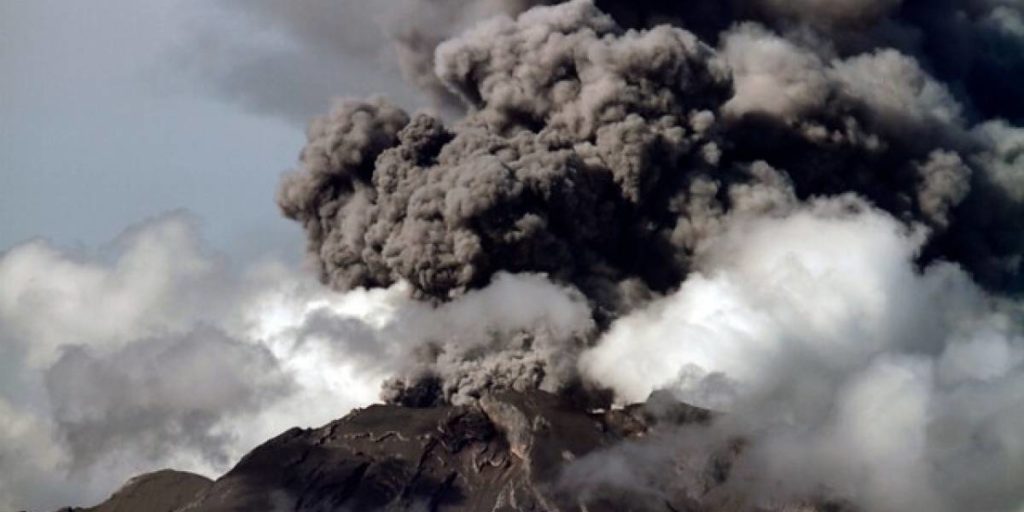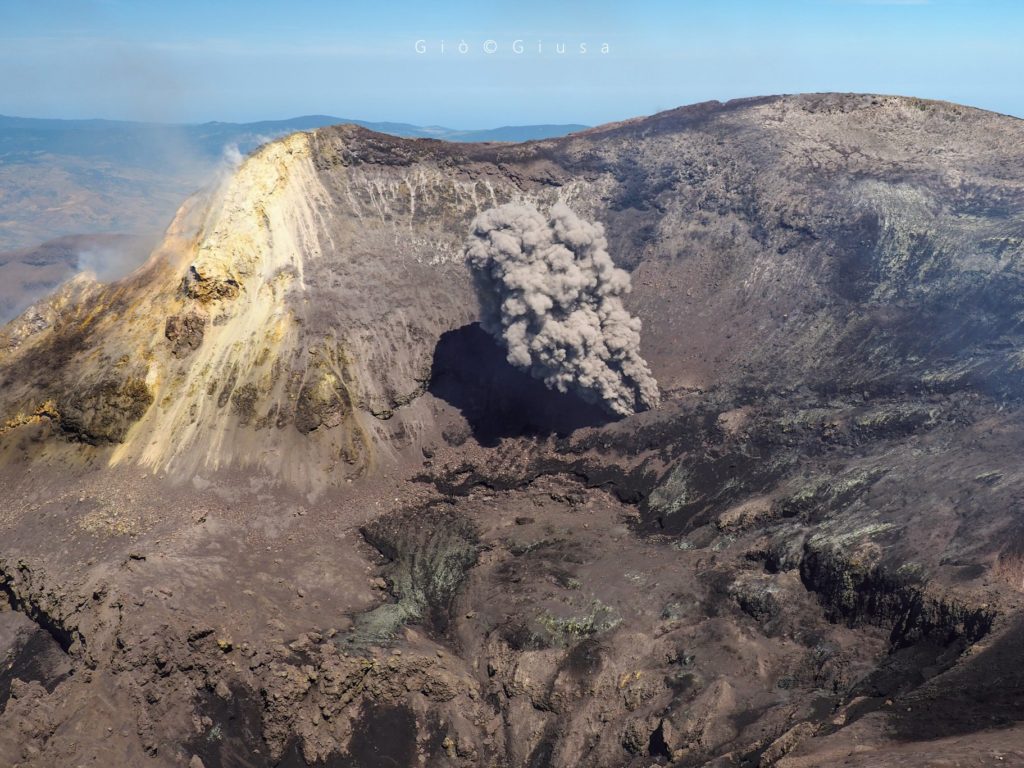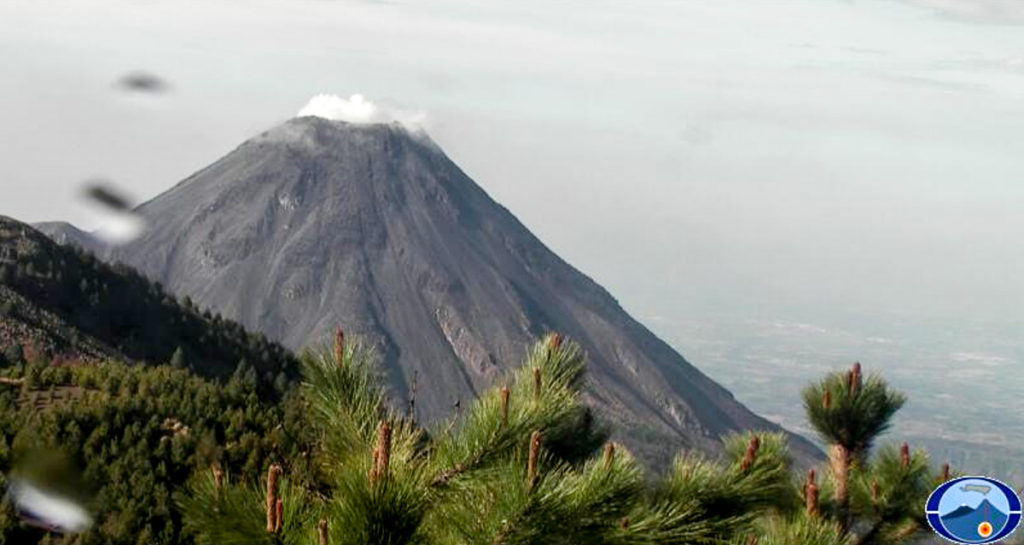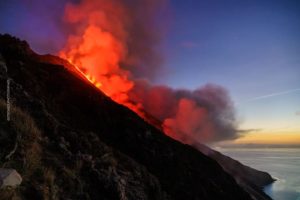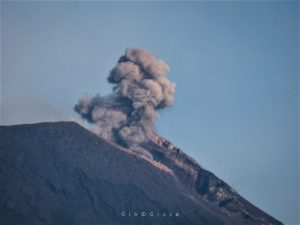June 16 , 2019.
Chile , Nevados de Chillan :
Volcanic Activity Report (RAV), Volcanological Observatory of the South Andes – Ovdas, 14 June 2019 16:15 HL.
Current alert level: ORANGE
Volcanic monitoring
Seismic activity: During the last 24 hours, the monitoring network of the Nevados volcanic complex in Chillan continues to record long-period seismicity (LP) and tremor episodes, with seismic energy remaining at moderate rank . The seismicity LP and TR being related to the occurrence of explosions which impulses the surface activity and is associated with the variation between the growth and the partial destruction of the viscous lava dome in the crater Nicanor.
Observations:
The weather conditions did not show any diurnal surface activity.
Other observations:
⦁ Infrasound sensors recorded acoustic signals associated with explosions (EX) with maximum values and less than 0.03 Pa (reduced to 1 km as a reference).
⦁ No thermal radiation was reported according to the information processed by the MIROVA group.
Danger:
Exposure / Specific risks:
After one year of observation, the dacitic dome maintains a low growth rate, with values around 0.003 m3 / s. Under these conditions, and if a major explosive event occurs, global statistics indicate that in 64% of cases it will be associated with a moderate to low explosive explosion (IEV = 0 to 2).
On the other hand, since the appearance of the dome in December 2017, there have been sporadic explosions with energy levels above the average of the current eruptive cycle. The area impact of this is limited to a radius that is not greater than 1 km around the active crater.
…/…
Read the full report: http://sitiohistorico.sernageomin.cl/reportesVolcanes/20190614052034453RAV_Ñuble_Junio_2019_Nº165.pdf
Source : Sernageomin.
Photo : Publimetro
Indonesia , Dukono :
Activity Level at Level II (WASPADA). The Dukono volcano (1229 m) is experiencing a continuous eruption. The top of the volcano was visible until it was covered with fog. The smoke from the main crater was white / gray, 600 meters high. An eruption projected 600 meters from the main crater a gray / white smoke.
According to the seismographs, dated June 14, 2019, it was recorded:
1 distant tectonic earthquake
1 local tectonic earthquake
6 distant tectonic earthquakes
Tremor continuous amplitude 0.5 – 8 mm, dominant 2 mm.
Recommendation: People around G. Dukono and visitors / tourists should not climb or approach the Malupang Warirang crater within 2 km.
VOLCANO OBSERVATORY NOTICE FOR AVIATION – VONA.
Issued: June 14 , 2019
Volcano: Dukono (268010)
Current Aviation Colour Code: ORANGE
Previous Aviation Colour Code: orange
Source: Dukono Volcano Observatory
Notice Number: 2019DUK35
Volcano Location: N 01 deg 41 min 35 sec E 127 deg 53 min 38 sec
Area: North Maluku, Indonesia
Summit Elevation: 3933 FT (1229 M)
Volcanic Activity Summary:
Eruption with volcanic ash cloud at 23h37 UTC (08h37 local)
Volcanic Cloud Height:
Best estimate of ash-cloud top is around 6493 FT (2029 M) above sea level, may be higher than what can be observed clearly. Source of height data: ground observer.
Other Volcanic Cloud Information:
Ash cloud moving to southwest
Remarks:
Eruption and ash emission is continuing
Source : Magma Indonésie , PVMBG.
Photo : Auteur inconnu.
Spain , Pico Viejo (Tenerife) :
14/06/2019 21:15 UTC. Seismic activity north-east of Guía de Isora – south-west of Pico Viejo (Tenerife)
Today, at 14:28 (UTC), the IGN volcanic seismic monitoring network located a 1.9 MbLg hybrid earthquake at a depth of 13 km, in the north-eastern region of Guía de Isora and south-east of Pico Viejo, with high low frequency content and very clear P and S wave arrivals in several network stations. Then, a series of very small earthquakes (less than 0.5 MbLg) was triggered, of which 36 events have been located so far. At 17:58 (UTC), another earthquake occurred in the same region and had the same characteristics with a magnitude of 1.6 MbLg and a depth of 12 km. Between these two events, a total of 512 earthquakes, all of very small magnitude, were detected by the nearest seismic stations.
The occurrence of earthquake series of this type in an active volcanic zone such as Teide-Pico Viejo corresponds to expectations. The large number of seismic stations, with a great capacity of detection, on which IGN’s volcanic monitoring system currently counts, makes it possible to study these series in what constitutes undoubtedly a great advance in the knowledge of the system and in volcanic monitoring work in the Canary Islands.
The analysis of the data obtained by the GPS network does not show any significant deformations.
Since the IGN, we remain attentive to this activity and all other activities of the Canary Islands.
Source : IGN
Photo : real-estate-tenerife.eu
Italy / Sicily , Etna :
COMMUNICATION on the volcanic activity of June 15, 2019, 07:25:35 (UTC) – ETNA.
The National Institute of Geophysics and Volcanology, Osservatorio Etneo, announces that, from the analysis of the images of the cameras of the surveillance network, we observe an eruptive activity of the craters of the summit, in particular of the crater of the Voragine. The explosive activity with ash emission began in the afternoon of the 13th, with a frequency and intensity very variable and discontinuous in time. The phenomenon is located at the bottom of the crater of Voragine, where a new mouth is opening, which produces ashes that disperse quickly in the area of the summit. Associated with the ashes, we also have material fallout on the crater terrace. Today, inspections are carried out by INGV staff in the summit area. The average amplitude of volcanic tremor does not show significant variations, remaining in low values.
COMMUNICATION on Volcanic Activity of June 15, 2019, 10:33:45 (UTC) – ETNA.
The National Institute of Geophysics and Volcanology, Osservatorio Etneo, informs that during the inspection of about two hours by the staff of the INGV, near the Voragine, the explosive activity observed in the crater confirms that Voragine continues to emit ashes, with varying intervals between 2 and 10 minutes, most are silent explosions, sporadically accompanied by explosions and the emission of materials falling partly outside the edge of the crater. Regarding the average amplitude of volcanic tremor, there is no significant change. However, in recent hours, while remaining confined to low values, it seems to show a slight and gradual upward trend. Infrasonic signals are at a low level.
The images show a particularly strong explosion, at 4:13 UTC (6:13 local), with emission of hot material. They were taken with thermal cameras in Bronte and on the Montagnola.
Source : INGV.
Photos : Gio Giusa , INGV.
Mexico , Colima :
Weekly technical bulletin of the activity of the Colima volcano . Date: 14-Jun-2019, Bulletin No. 125.
Seismic activity:
Last week, 6 low intensity explosions, 22 high frequency (HF) events, 2 long period (LP) events, 14 landslides and 18.35 min of low amplitude tremor were automatically recorded.
Visual observations:
During the reporting period, small explosions and intermittent releases of steam and gas mainly from the northeast side of the crater continue to be recorded. When visibility allowed, the fixed thermal camera located south of the volcano recorded thermal anomalies related to the explosions that occurred.
Geochemistry:
No measurements of SO2 flow during the week were made.
Remote perception:
No thermal anomalies detected by the MIROVA satellite system were observed during the last week.
Diagnostic :
The volcano maintains an explosive activity of low intensity. The occurrence of these events indicates that the gas associated with the moving magma has reached superficial levels. This activity can continue and increase in intensity over the next few days or weeks. The staff in charge of monitoring the volcano is attentive to possible changes and changes in activity.
Possible scenarios from days to weeks:
1. Low to moderate explosions continue.
2. There is new growth of lava dome at the top with collapses of incandescent material and lava flows.
Source : RESCO-CUEV-Facultad de Ciencias Universidad de Colima
Photo : afmedios.com


